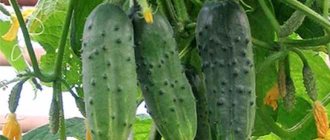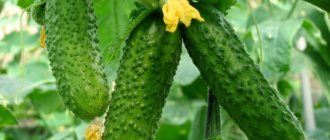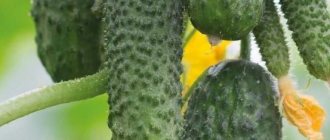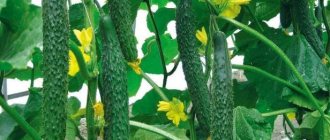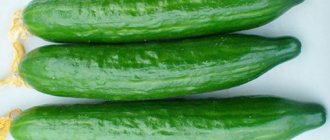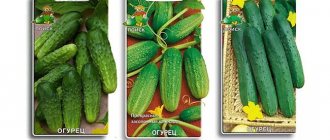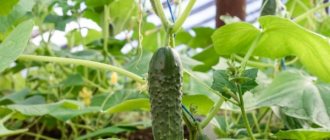History of selection
The variety was developed in 2007 in Russia, thanks to the work of agrotechnical breeders.
The authors of the variety were a team of breeders consisting of 3 people:
- M. I. Kirillova;
- I. N. Dubinina;
- S. V. Dubinina.
Did you know? If you wipe the bathroom mirror with a piece of raw cucumber pulp before taking a shower, it will not fog up.
The main features that distinguish this hybrid from other varieties:
- the ability to maintain its size and taste even after being on the lashes for a long time;
- the presence of a gene that suppresses the accumulation of bitterness;
- the ability to form a large number of fruits in relatively small areas (suitable for growing on a balcony), without compromising quality.
Description of the cucumber variety Prestige F1
Cucumbers "Prestige F1" are a first generation hybrid. The variety is popular among Russian gardeners. They value it for its excellent taste and high yield. Cucumbers can be grown in open and closed ground. With proper care of the plant, you can get a yield from 1 sq.m to 25 kg.
Bush
The trellis method is used to grow the plant. Tie it up after 3 leaves appear. A powerful indeterminate bush with medium climbing habit. Many bunched ovaries are formed on the main stem. Strong loops reach a length of 80-150 cm.
The flowers are predominantly female. Pollination is parthenocarpic. The leaves are medium in size. The surface is smooth, painted dark green. The edges of the leaf are wavy. The root system is well developed. The length of the rhizomes reaches 30 cm.
Fruit
The plant has a long fruiting period. The standard size of cylindrical greens is 8-9 cm. The average fruit weight is 50-95 g. The surface of cucumbers is very bumpy. At the end of the tubercles there are sharp spines. The skin has a dark green color. Light stripes are clearly visible on its surface.
The juicy pulp has a pleasant sweetish taste without any bitterness. When biting the fruit, a characteristic crunch is produced. There are no voids inside the fruit. The seeds are small. Greens are suitable for making salads. They can be salted and pickled.
After harvesting, the fruits retain their appearance for a long time. They perfectly tolerate long-distance transportation. Fruiting lasts from June to September.
Distinctive features
Plants of indeterminate type, medium height, female flowering type. The leaves are medium dark green. The ovaries are formed in bunches of 3-4 pieces.
The fruits are cylindrical in shape. The color is dark green with small white stripes and slight pubescence. The skin is covered with small whitish prickly spines. The length of cucumbers is 8-9 cm, weight is about 70–90 g.
Composition and properties
The calorie content of fruits per 100 g is 15 kcal.
The nutritional value:
- proteins - 0.8 g;
- carbohydrates - 2.5 g;
- fats - 0 g.
Fiber in vegetables has a beneficial effect on the functioning of the gastrointestinal tract. The fruits contain vitamins B, C, E, K, organic acids, macro- and microelements (potassium, sodium, phosphorus, calcium, magnesium, fluorine, iron, zinc).
Cucumbers are 95% composed of special structured water; they cleanse the body of toxins, heavy metals and toxins.
Photo
The photo shows the Prestige cucumber in all its glory. This cucumber seems to be asking to be put on your table or in a jar as a vegetable preserved for the winter:
Advantages of the variety
Easy to care for the plant
The choice of variety is made according to the main criteria: requirements for planting, care, fertilizer and harvest amount. Shchedrik f1 combines ease of care and high productivity at minimal cost to the gardener. Advantages of a hybrid:
- good keeping quality;
- grown cucumber is stored for a long time and can be easily transported;
- hybrid resistant to diseases (fungal and infectious);
- suitable for planting on any soil (indoor and outdoor);
- universal in use.
The fruits rarely accumulate bitterness, so they are used for mass sales. Self-pollinating inflorescences do not require the presence of insects - planting is carried out at any time of the year.
Productivity increases due to watering and fertilization. Ripe fruits are used for preparations for the winter.
Characteristics of Prestige F1 cucumbers
Prestige has proven itself well among vegetable growers due to the following characteristics:
- the root system is developed, so the bushes easily absorb moisture, oxygen and nutrients from the soil (the length of the rhizomes is up to 30 cm);
- powerful and strong vines of medium length (80–150 cm), but the bushes themselves are large;
- female inflorescences predominate;
- the hybrid does not require pollination by insects;
- the leaves are dark green, have a smooth structure and wavy edges;
- The taste of the fruit is excellent: no bitterness, slightly sweet, crunchy in the mouth;
- the yield is high: 1 bush produces up to 6 kg of vegetables;
- the hybrid is resistant to diseases and temperature changes;
- seedlings easily tolerate transplants.
Climatic growing conditions
The variety is adapted for cultivation in the northern and central regions of the country. It tolerates temperature changes well. In the Central Black Earth and West Siberian regions, cucumbers can be grown in open ground.
Productivity
F1 hybrids are the most productive, so all of them are included in the Russian farm register. If you follow the planting rules and timing of sowing seeds, you can get an average of 14 - 17 kg per square meter.
The weight of one Prestige F1 cucumber ranges from 45 to 100 g. Productivity can be regulated by fertilizers - plants love organic fertilizing with humus and humic additives in the form of watering. All such activities improve nutritional value and yield.
Advantages and disadvantages
Pros:
- precocity;
- the ability to sow hybrid seeds repeatedly during the season;
- prolonged fruiting;
- significant productivity;
- versatility of use;
- excellent taste and pickling characteristics;
- transportability and keeping quality;
- marketability and presentability;
- tolerance to adverse weather conditions;
- complex immunity to fungal pathogens.
Minuses:
- inability to use self-collected seed;
- preventive treatment against insect pests.
Advantages of Prestige F1 cucumbers
Before purchasing and planting a Prestige F1 cucumber, you need to find out what advantages the hybrid has in general.
- Prestige F1 is a parthenocarpic species. It does not require pollination by bees and does not form barren flowers.
- The taste is rated at the highest level. It is sweet, without bitterness, with a pleasant aftertaste.
- The hybrid is suitable for growing in open ground, greenhouses, on the balcony and even indoors.
- The plant is resistant to stressful growing conditions, temperature changes, frequent rains or drought.
- Transportability is excellent.
- Zelentsy of commercial quality.
- The fruits are resistant to yellowing.
- Fruiting is extended, the yield is sufficient. You can collect 15-25 kg of greens per square meter.
Prestige F1 is a parthenocarpic species, does not require pollination, does not form barren flowers
Important! The Prestige F1 cucumber hybrid can be grown using a simple method, horizontally, so that the vines spread along the ground or on a trellis.
Disadvantages of the variety
Not a single variety or hybrid of cucumbers can boast of the absence of shortcomings. What are the disadvantages of the Prestige cucumber:
- The yield of this hybrid depends on the quality and type of care.
- Cucumber Prestige is prone to powdery mildew, gray rot, and bacteriosis.
List of varietal advantages and disadvantages
The seed producer highlighted the following positive characteristics of his hybrid:
- Immunity to cucumber diseases. Only the breeders did not specify which ones specifically.
- Stress resistance in the garden. Cucumber has reduced sensitivity to sudden changes in temperature, cloudy, humid periods of summer.
- Early mass yield of the crop.
- Good taste.
- Decent yield. A high proportion of commercial quality greens in the total volume.
- Extension of the fruiting process.
- Long-term preservation of the harvested crop. Availability for transportation.
Cons of the Prestige cucumber:
- breeders focus specifically on the canning purpose of the crop;
- It is impossible to independently reproduce seed material.
Features of agricultural technology
Prestige F1 cucumbers can be grown by direct sowing in the ground or by seedlings. But in the middle and northern regions of Russia, the seedling method is usually used to get an earlier harvest.
Seeds for seedlings are sown a month before transplanting to a permanent place, to a depth of no more than 2 cm, otherwise they simply will not sprout.
For the first time, they are covered with film so that they germinate faster and are opened only to water or ventilate for 10-15 minutes.
Grown cucumbers are planted in a permanent place around May.
When the seedlings appear, the seedlings need to be properly cared for, watered on time, fed as needed, provided with normal lighting and a low temperature (so that the seedlings do not stretch out). Grown cucumbers are planted in a permanent place around May.
It is necessary to plant seedlings or sow seeds in well-warmed soil (+15…+20 degrees). It must be neutral acidity, loosened, fertilized. Cucumber Prestige F1 is suitable for compact planting in a small area. The best crop predecessors are cabbage and legumes.
Interesting! Prestige F1 is one of the few types of cucumbers that tolerate picking and transplanting well at a young age. But in order for the root system of seedlings to take root faster and not be injured, it is necessary to plant in heated soil!
If the region is warm enough and cucumbers have a lot of time to develop, you can sow the seeds immediately in a permanent place, in open or closed ground, without making seedlings. Sowing is carried out at the end of May in soil fertilized with organic matter. The planting pattern is 50x30 cm. Until the shoots appear, the bed is covered with agrofibre (white) or transparent film.
Growing methods
Prestige cucumbers are grown in two ways - seedlings and non-seedlings. Let's consider both methods in more detail.
Seedling method
Seeds must be planted 1 month before the intended transplant. Standard terms:
- last week of March;
- first half of April.
Supports certain conditions:
- temperature regime 25-27 degrees before germination, after within 20-22 degrees;
- humidity no more than 80%;
- watering with a spray bottle;
- lighting for 14-15 hours throughout the day;
- feeding at the stage of 1-2 leaves and after 2 weeks;
- hardening for 10 days before transplantation.
The bushes are transplanted into the greenhouse upon reaching 27-30 days (there should be 3-4 true leaves). Dates: second half of May.
In a seedless way
Seeds, like their analogue, are sown directly on the site (in holes or grooves 3-4 cm deep). They adhere to a placement pattern of 30 by 50 cm. Before the seedlings appear, they cover the ground with covering materials.
The soil should be heated to 12-14 degrees at a depth of 5-6 cm. The air temperature should be maintained at 18-20 degrees.
Planting cucumbers Prestige F1
Cucumber is grown through seedlings or by direct sowing into a plot. For the crop, neutral soil is selected - sandstone or loam.
Deadlines
Cucumbers of the Prestige F1 variety can be planted in seedlings or sown directly into holes. Depending on the chosen planting method, the timing of the procedures will differ:
- end of March - beginning of April - with seedling method;
- early June - when sowing in open ground.
Preparing the bed
Prestige cucumbers are planted in nutritious, moisture- and breathable soil. Too dense soils are not suitable - cucumbers quickly get sick in them and bear little fruit. These plants have a very shallow and sensitive root system that needs plenty of air. Therefore, the soil must dry out quickly and moisture must be supplied regularly.
The best option is to plant Prestige cucumbers in a warm bed.
Any plant debris, from large branches to fallen leaves, can be sequentially laid out in warm ridges. In 3-4 years, all components will be completely rotted. During the decomposition process, heat will be released, which cucumbers value so much. The top layer is 30 cm. This is exactly the length of the cucumber roots. A warm bed is prepared in the fall. In spring, seedlings of the variety can be planted in it 1-3 weeks earlier than the standard time. The soil temperature required for planting cucumbers is +15°C.
Germination of seeds
Seeds of the Prestige variety are soaked in a solution of potassium permanganate, Zircon or Epin for several hours and immediately planted in peat cups or peat humus tablets. Cucumbers have sensitive roots and the culture does not like transplants.
For this reason, many gardeners prefer to sow cucumbers directly into the ground. The Prestige variety is an early variety, so even without seedlings it can bear fruit in late July-early August. The seeding depth of Prestige variety seeds when sowing directly into open ground is 3-4 cm. Sowing time is the second half of May - early June. If necessary, plantings are covered with film.
Growing seedlings
Using the seedling method, you can speed up the first harvest by a couple of weeks. This is important for farmers who sell cucumbers in bulk. It is important to correctly calculate the timing of sowing - about a month before planting in open ground, when the temperature outside becomes higher.
Greenhouse or indoor seedlings are watered twice a week with warm water. Once the second true leaf appears, the Prestige F1 cucumber is fed with a complex fertilizer, for example, nitoammophoska.
10 days before planting in open ground, seedlings begin to be ventilated (hardened off). To do this, open the doors in the greenhouse on one side.
Planting seedlings in the ground
In mid- and late May, depending on local weather conditions, cucumbers are transplanted into the garden. To do this, choose a warm sunny morning. If the weather is cool, you can create raised beds by raising them 25 cm from the base. Planting is carried out according to the 30x50 pattern, that is, the distance between bushes in a row is 30 cm, the distance between rows is 50 cm.
Growing and care
Cucumbers of the “Prestige F1” variety can be grown by seedlings or seeds. Gardeners independently choose their planting method based on their preferences and desire to get a harvest at a certain time. Cucumbers planted in beds in the form of seedlings have earlier ripening periods.
Landing
The soil for planting the plant must have a neutral environment. Loamy soil is best suited for the hybrid. The time for planting a plant depends on the chosen method.
The optimal period for planting seedlings is the end of March or the beginning of April. The best time for seeds is early June. The soil temperature during planting should be at least +15℃, and the daytime air temperature +15-20℃.
The technology for growing a hybrid has its own peculiarities. The place for cucumber beds is chosen in an area protected from drafts and well lit. Seedlings are planted in the ground 25-30 days after emergence. By this time, 3-4 leaves should grow on the seedling.
Seeds are sown 2-3 pieces per hole. Their depth should be no more than 2 cm. Shoots appear 5-7 days after sowing. The optimal planting pattern for cucumbers is 50x30. The soil for planting is prepared in the fall. When digging, it is treated with copper sulfate and fertilized. The best autumn fertilizer is manure. It is applied to the soil at the rate of 10 kg per 1 sq. m of soil.
Top dressing
The amount of fertilizing depends on the quality of the soil. During the growth period, cucumbers are fertilized at least 3 times. It is better to do this 5-6 times, but not more than once a week. During the growing season, fertilizing is applied 4 times. On days 10-14 after picking the bushes, superphosphate or other nitrogenous fertilizers are added to the soil.
Superphosphate
Wood ash
Mullein
During the flowering period, the plant needs to be fed with potassium, phosphorus and calcium. After the ovary appears, potassium-phosphorus solutions are added to the soil. 14 days after this, the bushes are fed with complex mineral fertilizers. The best organic fertilizers for cucumbers are wood ash, bird manure and mullein.
Watering
Cucumbers are considered moisture-loving plants, but excess moisture leads to their death. The frequency of watering depends on weather conditions. The water must be settled before watering. It should not contain chlorine and be warm.
It is recommended to water cucumbers after sunset. This should absolutely not be done in the midday heat. This will lead to the death of the plants. Loosening the soil after watering helps maintain the required soil moisture.
Landyshev V.V.
Scientist agronomist
It is best to fertilize cucumbers for the first time with calcium nitrate 10 days after planting the plant in the ground. Fertilizer dosage is 20 g. for 10 liters of water.
— Landyshev V.V. Scientist agronomist
Caring for Prestige cucumbers
Regardless of the chosen sowing method, further care for cucumbers of this variety will be identical. The main task is to apply a sufficient amount of fertilizer and ensure high-quality soil moisture.
Watering mode
Watering is carried out at the root using a watering can with a long nose equipped with a sprayer at the end. Other watering methods are ineffective. The water temperature should vary within +25. +28°С. In cool, rainy weather, plant roots do not absorb moisture well, which leads to its retention in the soil. On cloudy days it is better to avoid watering altogether.
Irrigation scheme:
- before flowering and during the flowering period in hot weather - once a day, 0.5-1 liters per bush;
- during the fruiting period - once every 2-3 days, 8–12 l/1 m²;
- during the period of decreased fruiting activity - once a week, 0.5-0.7 liters per plant.
Feeding
It is best to alternate organic fertilizers with mineral complexes. Organic matter is introduced by the root method; mineral complexes can be applied both at the root and by spraying on the leaf.
For the entire active growing season, 4 additional feedings are applied:
- at the moment of appearance of 4 full leaves - nitrogenous fertilizers;
- at the beginning of flowering - potassium, phosphorus, calcium;
- during the fruiting period - potassium, phosphorus, minimum nitrogen;
- 2 weeks after the third - the goal is to prolong fruiting; plants need nitrogen, potassium, phosphorus and calcium from microelements.
Foliar fertilizers
Foliar feeding stimulates the absorption of nutrients from the soil by the rhizome and also helps speed up the processes of photosynthesis.
They are carried out according to the following scheme:
- a week before flowering or at the time of flower bud formation;
- immediately after flowering;
- during the period of active fruiting.
Foliar complexes are applied 2 weeks after root feeding. Throughout the growing season, you can use the same universal composition. For example, an ash solution. Suitable raw materials for the solution are formed after the combustion of organic substances, such as wood. Add 100 g of raw material to 10 liters of water. This fertilizing can be applied every 10 days. To increase the efficiency of pollination, a sweet solution can be applied to the blooming buds. For this, 100 g sugar and 0.5 tsp. boric acid is dissolved in 1 liter of boiling water. After cooling, the solution is carefully applied to the outer part of the flower so as not to wash off the pollen. To prolong fruiting, you can use an infusion of rotted hay: 1 kg of rotted hay is poured into 10 liters of water and left to infuse for 2 days. This composition not only prolongs the fruiting period, but also serves as an effective protection against powdery mildew.
Root fertilizers
For the first time, plants can be fed with a mixture of urea and superphosphate. To do this, you need to dissolve 60 g of superphosphate and 20 g of urea in 10 liters of water. The solution is applied at the root in parallel with watering, 500 ml for each bush. You can replace mineral fertilizers with a solution of bird droppings. To do this, add 1 kg of litter to 15 liters of water. If cow manure is used, then add 1 kg of manure to 8 liters of water. The prepared solution is watered at the roots of the plants, 1 liter per bush.
At the flowering stage, add to 10 liters of water:
- 40 g superphosphate;
- 30 ammonium nitrate;
- 20 g potassium salt.
The third fertilizing is carried out with organic matter so that the fruits do not accumulate toxic substances. You can use mullein or chicken droppings. At the fourth stage, you can water by adding 2 tbsp for every 10 liters of water. l. soda
Bush garter and shaping
Bushes of this variety of cucumbers need garter and reliable support. This allows you to regulate growth and also reduces the risk of the spread of pests and microbes when the above-ground parts of plants come into contact with the soil. Even before planting seedlings or sowing seeds in a permanent place, a trellis is stretched along the beds. Along the entire length of the bed, piles are installed, to which a fishing line is attached at a height of 150 cm.
When the plants reach a height of 15 cm, a piece of twine is tied to the fishing line, opposite each bush. The bottom loop of twine is secured above sheets 2 and 3, leaving it free with the expectation that the stem will become thicker. Forming a bush in open ground is not required. Flower buds form along the main stem. They reduce the load on the vine as the fruits ripen by removing them on time, thereby making room for new ovaries.
Soil care
After each moistening, fertilizing and rain, cucumber beds need to be loosened and weeds removed. With daily watering, loosening is carried out every 2-3 days. Mulching when growing this variety of cucumbers is advisable only when watering begins once a week. Peat or compost can be used as mulch.
Possible difficulties
Features of cultivation:
- in open ground, cucumbers are protected from spring frosts by covering with agrofibre or film;
- plantings are watered regularly, especially if the summer is hot and dry: this will relieve the fruits from developing bitterness;
- until the ovaries have formed, the seedlings are watered every 2-3 days;
- excess foliage and shoots are removed, and the bushes are hilled up.
Agrotechnical measures
Caring for cucumbers includes:
- Water as needed. In hot weather, up to 2 times a day - morning and evening. In rainy weather - every other day.
- Loosen the soil 1-2 times every two weeks to enrich the roots with oxygen.
- Timely application of fertilizers – up to 5-6 times per season.
- Timely harvesting of greens to obtain maximum yield.
- Construction of trellises for vertical growing.
When properly grown, “Prestige F1” will delight you with a bountiful and stable harvest.
Harvest and storage
Parthenocarpic varieties are harvested as often as possible: at least 2-3 times a week. It is better to collect it daily - this way the cucumber sets and grows even more fruits. Prestige cucumbers are harvested in July-August.
For long-term storage, only freshly picked, not overgrown and not too small fruits, with intact skin, without spots or damage, are selected. Cucumbers are wrapped in a damp cloth and stored in the refrigerator. The fabric is regularly rinsed in clean water and vinegar. In this form, greens of the Prestige variety can remain fresh for up to 3-4 weeks.
Diseases and pests
The Prestige variety is resistant to major cucumber diseases. It tolerates temperature changes well, is relatively cold-resistant, and is not prone to getting sick. But in areas with unfavorable microflora it can be affected by typical diseases.
Cladosporiosis
The causative agent of cladosporiosis is the fungus Cladosporium cucumerinum, which loves high humidity and heat. In moderately heated (up to +25C) greenhouses, with an abundance of relatively dry air, it is less common. The leaf spots are dark brown or lighter olive in color. This disease of cucumbers is provoked by temperature changes, dampness, and slush. Cucumbers most often suffer from olive spotting in cold summers and with excessive watering using sprinkling. Water and precipitation are the main source of spread of the disease.
First aid: stop watering, treat with copper oxychloride 4% or Fundazol.
It is highly advisable to raise and equalize the temperature. The temperature should not fall below +18°C.
Downy mildew
Downy mildew is one of the most common cucumber diseases. The main symptom is numerous pockmarked light yellowish spots on the leaf. Gradually the spots grow and the leaf dies. The causative agent is fungi from the Peronosporaceae family. Spread by air.
Provoking factors: high humidity, watering with cold water, thickened plantings, non-compliance with crop rotation, temperature changes during the day and untimely harvesting of fruits.
Treatment: treatment of Prestige cucumbers with Bordeaux mixture (100 g of copper sulfate and 100 g of slaked lime per 10 liters of warm water). The drug "Ridomil" is suitable. It is very advisable to increase the temperature in the greenhouse to +25°C and monitor its stability. Cucumbers in open ground can benefit from sheltering at night.
Powdery mildew
The main problem of cucumbers in the middle zone. White powdery spots on the leaves are similar in shape and distribution to downy mildew, but have an ashen tint. The causative agent is a parasitic fungus; the types of fungi can be different. Erysiphe cichoracearum is rampant in the northern regions, and Podosphaera fuliginea is rampant in the southern regions. If powdery mildew was noticed on the site in previous years, this year it is advisable, without waiting for the problem, to regularly spray the plants of the Prestige variety with Fitosporin or whey.
It is important to monitor the temperature. The causative agent of powdery mildew freezes and does not develop at temperatures above +18...+20°C. Urgent treatment is copper-containing drugs. In the future, you should review the agricultural technology of the variety: thoroughly disinfect all tools, greenhouses and the greenhouse, organize shelters for the plants at night, water only with warm water.
